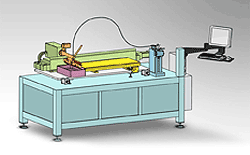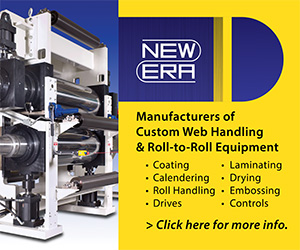Pilot Coaters: Small Volume, Big Advances
- Published: October 01, 2010, By By Edward D. Cohen, Edward D. Cohen Consulting
Until recently, development of laboratory and pilot coater technology has been relatively stagnant. The many improvements — increased coating speeds, improved coating quality, slot die coaters, multi-layer simultaneous coating, increased range of coverage — have not been applied to laboratory and pilot coaters.
The reason for this lag is because the primary focus of applying new technology has been in building new production coating lines and upgrading existing lines. There appeared to be minimal return on investment for laboratory developmental facilities. In addition, no effective alternatives were available.
The standard laboratory benchtop has not changed fundamentally for many decades. Typically a 1-2-sq-ft sheet is coated using a doctor device such as a die, blade, or Mayer rod. The sample then is dried with ambient air on a benchtop, often assisted by a hair dryer, or in a laboratory oven. The advantage of this method is that formulators can test their own coatings, the hardware cost is inexpensive, and it is a familiar technique with a long tradition.
Some of the disadvantages of this process are as follows:
- Correct coverage is hard to obtain
- Coating quality is poor and is not reproducible
- No correlation with manufacturing process
- Drying is not controlled
- Reproducibility is poor
- Reformulation is needed for scaleup
- Need to coat many samples for one good sheet to test
- Costs are high and process is slow
The traditional second step in the development and scaleup of new and improved coated products is the pilot coater in which the first continuous coatings are made. There are various types of pilot machines in use.
Some are old manufacturing coaters. Others are custom-made machines that can be expensive to purchase and use. They often do not have the current technology, coating methods, drying, curing, control system, and web transport that are required to coat new products or to optimize exciting products.
Often no pilot coaters are available. As a result, this step often is bypassed and experiments run on manufacturing machines. The disadvantages of this are the expense, lack of sufficient experimental time, and inadequate technology. The lack of facilities in this area restricts the coatings that can be made, slows down the development process, and restricts the new technology that can be introduced.
Current Technology
The disadvantages of the traditional process — along with increased competition, the need to have shorter product development cycles, and the need to manufacture small volume products — resulted in programs by coating companies to improve the developmental coating process.
Simultaneously, converting hardware manufacturers determined there was a market for improved developmental coating process hardware and started programs to design and manufacture hardware to meet these needs.
Hardware Availability
The consequence of these efforts has been the introduction of several coaters that provide major improvements in the developmental coating process. These products have several common elements:
- Majority of operations are mechanized
- Modules are scaled-down versions of standard process
- Standard coating methods are used
- Drying and coating are coupled
- Standard process instrumentation and control systems are used
- Precision and quality fabrication
- Computer control
- Standard modules for maximum flexibility and minimized costs
- Cost efficient
There are four major classes of new developmental coaters, which are described in the following sections. There are many coaters in each class; however, the limited number described illustrate the concepts of the class. A detailed list of available coaters can be found in ThomasNet (www.ThomasNet.com) or by using Internet search engines.
Continue on Page 2
Lab Sheet-Fed Coaters
Laboratory sheet coaters are machines in which the entire coating and drying process is mechanized. A variety of coating heads — knife, roll, gravure, and multiple roll configurations — can be used depending on the specific coater selected. Both coaters and dryers with controllable conditions are available. Coaters can be coupled with a programmable dryer so the sheet is fed directly into it for controlled drying. These machines improve the efficiency and quality of the lab coating process because they have the following capabilities:
- Coat sheets with standard coating methods
- Control and reproduce drying conditions
- Improve quality and reproducibility
- Coat a wide range of wet thicknesses
- Improve productivity (5-10 min/coating)
- Provide more experimental flexibility
- Improve costs significantly
- Reduce operator sensitivity
- Give rapid payback

There are some automated sheet coaters that can be purchased with only coating and no drying. It is recommended that machines with only drying capability be used. A controlled dryer is essential to reproduce quality and to start optimizing drying conditions for scaleup and manufacturing.
Innovative machines in this class are the automated PATFiCoat System and BT Coater produced by BARS Precision. Figure 1 shows the major coater components. They are automated, benchtop, slot die, sheet coating machines that produce a long sheet with excellent quality and reproducible precise coating weight. They can be tested in actual applications. They use a small solution volume that permits evaluation of formulations in which limited amounts of ingredients are available. Key features are as follows:
- Pump flow rate precision ±0.2%
- Low solution volume
- Programmable thickness in cc/cm2, cc/m2, cc/ft2, mg/ft2, mg/m2
- Programmable temperature (independent controls for die and pump)
- Maximum coated area of 2,910 cm2 for 27.9-cm (11-in.) die slot; 10,600 cm2 for 10.1-cm (4-in.) die slot
- Fully automated thermal drying cycle
Continuous Lab Coaters
Continuous laboratory coaters have been developed and are available from several manufacturers. These are narrow, miniature coaters that consist of a scaled-down unwind, coater, dryer, control systems, web transport, and rewind.
These coaters use narrow webs (3-12 in.) and run at low speed (1-10 fpm). They are a good step in the conversion from a sheet process to a continuous web process. The advantages of these machines are detailed below:
- Can produce salable quality rolls using standard coating methods — slot die, doctor knife, and roller
- Hot air and infrared (IR)controlled drying
- Coat a range of coating weights and substrates
- Good operating economics that speed up development time
- Long samples for realistic internal and external evaluation
- Can gain insight into basic process data for commercial process
- Reliable performance results

An example of a continuous laboratory coater is the Werner Mathis KTF-S. Figure 2 shows the key elements of the coater, which has these key features:
- Width | 300 mm
- Line speed | 0.1-0.2 mpm
- Dryer air capacity | up to 1,000 m3/h
- Temperature range | up to 250 deg C
- Nozzle field length | 800 mm
- Winding diameter | 250 mm max.
- Laminator and IR predryer | available
In addition, if more capability is needed, the Werner Mathis BA Series offers a variety of coating methods.
Continue on Page 3
Modular Pilot Coaters
Modular pilot coaters are narrow, stand-alone, compact, multipurpose, continuous coating machines. These machines contain all of the elements — unwind, coater, dryer, rewind, controls systems, heating, and ventilating — and the power systems needed to continuously coat a precision salable product. The modular feature permits some customization of the dryer type, length, and coating methods.
They can function as an R&D pilot coater or manufacturing coater. Since they are available in widths up to about 15 in. and line speeds to 130 fpm, they also can be used to produce market developmental quantities of products if the narrow width is usable. They also can make production units more effective by off-loading small volume products.
The completed modules are shipped in two sections: coater and support systems. Therefore installation is not complicated. All of the pilot coaters have standard modules that can be assembled to meet specific needs.
Key features of these modular coaters are as follows:
- Several coating methods available — slot die, roll coaters, gravure
- Can be used for R&D, development, and production
- Can produce film for small volume products (10-15 M sq ft/yr at 15 in.)
- Flotation or IR dryers are available
- Commercial quality
- Reproducible and versatile
- Computer control systems
- Laminating and ultraviolet (UV) cure available
- Cost effective
An example of this class of modular coaters is the recently introduced LabMaster “Plug & Play” pilot coater from Faustel (see Figure 3). This is a very flexible coater that reproduces quality product with attractive economics. It can function as a pilot coater as well as a small-volume coater. Two versions are available to provide for various user requirements.

Some of the key features of this coater are as follows:
- Variety of coating methods available
- Water, solvent, or hot melt coatings
- Laminating
- Handles paper, film, foils, nonwovens, etc.
- Processes webs up to 300 mm (11.8 in.) wide × 300 mm outer diameter
- Runs at speeds to 30 mpm (98.4 fpm)
External Pilot Coaters
Other sources of pilot coating capability to consider are the coating hardware manufacturers and the pilot plants of toll coaters. The manufacturers have been upgrading their pilot plants so they can coat small volumes and handle a wide range of coverages and substrates. Thus, they can demonstrate new technology that could be built into new coating lines.
They have added web cleaners, UV curing, surface treatment, variety of coating methods, small-volume coating capability, and reduced contamination levels. Similarly, toll coating companies also have pilot coaters with new technology that can be used.
Laboratory Quality Control
The addition of these coaters into the coated product R&D process also requires improved uniform solution preparation and characterization. New mixing and dispersion equipment, improved temperature control, and additional filtration capability may be needed in the solution preparation process.
The following solution properties should be measured to ensure ongoing quality and reproducibility with the new coaters:
- Viscosity of the coating solution and the shear rate sensitivity
- Solids concentration
- Surface tension of the coating solution
- Surface tension and physical quality of the substrate
This data should be kept in a computer database along with computer process variables — such as drying conditions, coating conditions, ambient conditions — and product properties — such as coating weight and physical quality. Availability of this information will help reproduce quality products, provide scaleup and manufacturing conditions, and help all formulators improve products and reduce scaleup time.
Supplier Info
-
BARS Precision | www.barsprecision.com
Circle 321 or visit www.freeproductinfo.net/pff -
Werner Mathis | www.mathisag.com
Circle 322 or visit www.freeproductinfo.net/pff -
Faustel | www.faustel.com
Circle 323 or visit www.freeproductinfo.net/pff
Edward D. Cohen, PhD, of Edward D. Cohen Consulting, Fountain Hills, AZ, has 40+ years of experience in research and manufacturing technology. He is a technical consultant for the Assn. of Industrial Metallizers, Coaters & Laminators. Contact him at 480-836-9452; cohened146@aol.com.
This article is provided as a cooperative effort between PFFC and AIMCAL. Authors contribue to AIMCAL's technical and education offerings, which include the association's Fall Technical Conference, Converting School, AWEB Applied Web Handling Conference, and Ask AIMCAL. Visit www.pffc-online.com/events for meeting dates and locations.
The views and opinions expressed in Technical Reports are those of the author(s), not those of the editors of PFFC. Please address comments to the author(s).







